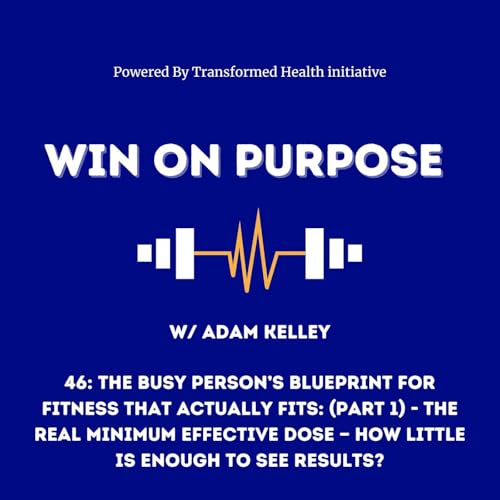
46: The Busy Person’s Blueprint for Fitness That Actually Fits: (Part 1) - The Real Minimum Effective Dose — How Little is Enough to See Results?
No se pudo agregar al carrito
Add to Cart failed.
Error al Agregar a Lista de Deseos.
Error al eliminar de la lista de deseos.
Error al añadir a tu biblioteca
Error al seguir el podcast
Error al dejar de seguir el podcast
-
Narrado por:
-
De:
Send us a text
Ever wonder, “What’s the least I can do and still see results?” You’re not alone—and the answer is better than you think.
The fitness industry glorifies more: more workouts, more sacrifice. But research proves otherwise. Just 150 minutes of moderate activity weekly can reduce disease risk by 40%, and 2–3 strength sessions a week builds muscle. It’s not about doing more—it’s about doing what matters consistently.
That’s the power of the Minimum Effective Dose (MED) approach. We offer three commitment levels:
- Baseline Builder: 3–4 days/week (~2 hrs total)
- Momentum Plan: 4–5 days/week
- Optimize Routine: 5–6 days/week
The best part? You can shift between them as life changes—without losing momentum.
Clients like Alex (busy dad and lawyer) dropped 16 lbs and reversed pre-diabetes with just 2 lifts + 3 walks weekly. Renee crushed her goals on 3 full-body workouts/week—after years of burnout from daily programs.
The secret? Doing the right things, consistently. Start where you are. Do what you can. We’ll help you stack the wins.
Book a free consult through the show notes or our site. Your sustainable fitness journey starts now.
Click Here To Send Us A Message!
Book Your Free Discovery Call! Complete this super short form.
References:
- Haskell, W. L., et al. (2007).
Physical activity and public health: Updated recommendation for adults from the American College of Sports Medicine and the American Heart Association.
Medicine & Science in Sports & Exercise, 39(8), 1423–1434.
https://doi.org/10.1249/mss.0b013e3180616b27 - Schoenfeld, B. J., et al. (2019).
Strength and hypertrophy adaptations between low- vs. high-volume resistance training: A systematic review and meta-analysis.
Journal of Strength and Conditioning Research, 33(Suppl 1), S1–S18.
https://doi.org/10.1519/JSC.0000000000002958 - Campos, G. E., et al. (2002).
Muscular adaptations in response to three different resistance-training regimens: Specificity of repetition maximum training zones.
European Journal of Applied Physiology, 88(1–2), 50–60.
https://doi.org/10.1007/s00421-002-0681-6 - ACSM (American College of Sports Medicine). (2017).
ACSM's Guidelines for Exercise Testing and Prescription (10th ed.).
Philadelphia, PA: Wolters Kluwer Health. - U.S. Department of Health and Human Services. (2018).
Physical Activity Guidelines for Americans, 2nd Edition.
https://health.gov/sites/default/files/2019-09/Physical_Activity_Guidelines_2nd_edition.pdf - Harvard Health Publishing. (2020).
Walking: Your steps to health.
Harvard Medical School Special Health Report.
https://www.health.harvard.edu/exercise-and-fitness/walking-your-steps-to-health
For Motivation and More Free Content, Visit Our THI Facebook Page!
Click Here And Follow Coach AK For Even More!
Join Our Free Facebook Group: Live Transformed: Rebuild Your Health, Habits, And Headspace
Instagram: @coachadamkelley
www.transformedhealthcoach.com



